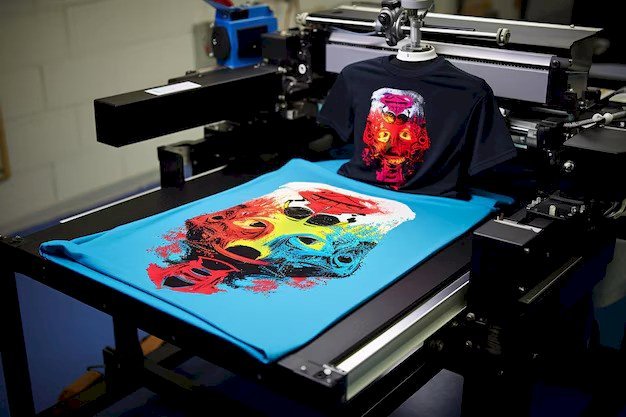Understanding Direct to Film Printing Technology
Learn how Direct to Film (DTF) printing works, its process, materials, and benefits. Discover why DTF is transforming custom apparel and product design.

Direct to Film Printing (DTF) prints designs onto PET transfer film, applies adhesive powder, cures the print, and heat-transfers vibrant, durable images to fabrics and other substrates — a fast, versatile alternative to DTG and screen printing.
The world of printing has evolved rapidly over the years. With new technology comes the opportunity for businesses to produce custom products with greater efficiency, higher quality, and more versatility. Among the latest innovations in the custom printing industry is Direct-to-Film (DTF) printing. If you’re not yet familiar with it, don't worry. In this article, we’ll learn about what DTF printing is, how it works, and why it’s become a popular choice for those looking to create vibrant and durable designs on a wide range of products.
What Is Direct-to-Film Printing?

Image source: pinterest.com
Direct-to-Film (DTF) printing is a method that involves printing designs directly onto a special transfer film, which is then applied to a variety of materials, typically using heat. This process makes DTF printing ideal for creating custom apparel, merchandise, and even promotional items. It combines the best features of traditional printing techniques while offering unique advantages like lower setup costs and more flexible product options.
While this technology is relatively new compared to methods like screen printing or Direct-to-Garment (DTG) printing, it has gained traction for its ease of use and cost-effectiveness. But what sets it apart from other printing methods? In the following sections, we’ll explore the unique process behind DTF printing and the essential components involved.
The Process Behind DTF Printing

Image source: pinterest.com
The DTF printing process is a multi-step procedure that ensures high-quality results, even with intricate or multi-colored designs. Here’s a breakdown of how it works:
Step 1: Image Creation and Preparation
The first step in the DTF printing process involves designing the image or graphic using specialized software. This can be done on a computer using programs like Adobe Illustrator or CorelDRAW. The design must be formatted for printing onto the film, which typically involves converting the image into a CMYK color model (cyan, magenta, yellow, and black). Once ready, the file is prepared for printing.
Step 2: Printing the Image on Film
Next, the image is printed onto a transfer film using a specialized DTF printer. These printers use water-based inks that are able to adhere to the film. The ink sits on top of the film, creating a vibrant and detailed design. This is a key advantage of DTF printing: the inks are able to produce vivid colors and high-quality details, even with intricate designs or fine lines.
Step 3: Powdering and Curing the Film
Once the image is printed on the film, the next step is to apply an adhesive powder. This powder sticks to the ink, creating a bond that will help the design adhere to the final material. After the powder is applied, the film is passed through a curing oven or heat press to set the adhesive powder. This process ensures that the design is solid and durable once transferred.
Step 4: Heat Transfer onto the Substrate
Finally, the transfer film is placed onto the desired material, such as a t-shirt, hoodie, or even a non-textile item like a tote bag or phone case. A heat press is used to apply heat and pressure, ensuring that the design transfers from the film to the fabric or other material. Once the heat press is done, the film is peeled away, leaving behind a high-quality, vibrant design.
Key Components of DTF Printing Technology

Image source: pinterest.com
DTF printing is more than just a fancy printer—it’s a combination of several key components working together to produce excellent results. Here's a breakdown of the essential tools involved:
Printers & Inks
At the heart of DTF printing are the printers and inks used in the process. DTF printers are specifically designed to handle the needs of the transfer film and water-based inks, which are ideal for producing vibrant designs. The inks used in DTF printing are similar to those used in other digital printing technologies but are specially formulated to adhere to the transfer film.
Transfer Film & Adhesive Powders
The transfer film is a critical component in the DTF process. It is typically made from a PET (polyethylene terephthalate) material, which provides a smooth surface for the ink to adhere to. The adhesive powder, applied to the printed image, helps ensure that the design bonds well with the fabric or substrate during the heat transfer process.
Heat Press Machines
The heat press machine plays a vital role in the final transfer of the design. It uses both heat and pressure to ensure that the design adheres to the material effectively. The type and quality of the heat press machine used can significantly impact the final product, ensuring that the print is crisp, vibrant, and long-lasting.
Advantages of Direct-to-Film Printing

Image source: pinterest.com
DTF printing has rapidly gained popularity, and for good reason. Here are just a few of the key advantages:
High-Quality Prints
DTF printing produces vibrant, long-lasting designs with crisp details. Unlike traditional screen printing, which can struggle with intricate designs or small text, DTF printing delivers exceptional color quality and precision, making it ideal for complex and multi-colored graphics.
Versatility
One of the standout features of DTF printing is its versatility. It works on a wide variety of materials, including cotton, polyester, leather, and even non-textile items like bags and phone cases. This makes it an excellent choice for businesses looking to offer custom products on various substrates.
Lower Setup Costs
Unlike screen printing, which requires creating separate screens for each color, DTF printing uses a digital method that doesn’t require this complex setup. This makes it more affordable for small to medium-sized businesses, as it reduces the overall costs associated with the printing process.
Shorter Production Times
DTF printing is much faster than screen printing, making it ideal for businesses that need quick turnaround times. Whether you’re producing a single custom t-shirt or a small batch of merchandise, DTF printing offers a faster production process, especially when compared to the labor-intensive setup required for screen printing.
DTF Printing vs Other Printing Methods

Image source: pinterest.com
When comparing DTF printing to other popular methods, such as Direct-to-Garment (DTG) and screen printing, there are a few notable differences.
DTF vs DTG:
While DTG printing uses inkjet technology to print directly onto the fabric, DTF printing offers superior flexibility in terms of material compatibility and lower setup costs. DTG printing is ideal for printing directly on garments, while DTF printing can be used on a wider range of products, including non-textile items.
DTF vs Screen Printing:
Screen printing is best suited for large orders with simple, bold designs. However, it requires significant setup time and costs, especially for multi-colored designs. In contrast, DTF printing is more cost-effective for smaller runs and intricate designs, with much faster production times.
Conclusion
DTF printing represents an exciting shift in the world of custom printing. With its high-quality results, versatility, and lower setup costs, it’s a technology that businesses of all sizes can benefit from. Whether you're looking to create custom apparel, promotional products, or unique merchandise, DTF printing offers a flexible and efficient solution. As the technology continues to advance, it’s clear that DTF printing will only grow in popularity and become a mainstay in the world of custom product creation.
If you’re considering incorporating DTF printing into your business, now is a great time to explore its capabilities and discover how it can elevate your custom products to the next level.
Frequently Asked Questions
1. What is Direct to Film (DTF) printing and how does it work?
Direct to Film (DTF) printing is a modern printing method where a design is first printed onto a special PET transfer film using CMYK and white inks. Once the design is printed, an adhesive powder is applied over the wet ink, helping it bond with fabrics during the heat transfer stage. After curing the film, the design is pressed onto garments or other materials using heat and pressure. This process creates a durable and vibrant print that adheres well to various surfaces, making DTF an efficient and versatile alternative to traditional printing methods like screen or DTG printing.
2. What materials can DTF printing be applied to?
DTF printing works on a wide variety of materials, which is one of its biggest advantages. It can be used on natural fibers such as cotton, as well as synthetic fabrics like polyester, nylon, and blends. Beyond textiles, DTF can also be applied to treated surfaces like leather, canvas, or even wood and certain plastics. This flexibility allows designers and small businesses to produce custom apparel, tote bags, hats, and promotional items without needing different equipment for each substrate.
3. Does DTF printing last, and how durable are the prints?
Yes, DTF prints are known for their exceptional durability. When properly applied and cured, a DTF print can easily last through 40 to 50 or more wash cycles without cracking, peeling, or fading. The adhesive used in the transfer process ensures that the design bonds strongly to the fabric, maintaining its color and texture over time. Longevity also depends on how the garment is cared for, which includes washing it gently and avoiding excessive heat during drying or ironing.
4. What temperature, pressure, and time settings are ideal for DTF transfers?
The optimal settings for DTF printing generally range between 300°F and 325°F (around 150°C to 165°C), with medium pressure for about 10 to 15 seconds. However, these values may vary slightly depending on the type of film, fabric, and heat press being used. Following the film manufacturer’s recommendations ensures proper adhesion and prevents issues like under-curing or over-melting. Getting the right combination of heat, pressure, and timing is crucial to achieve smooth, long-lasting prints.
5. What is the difference between hot peel and cold peel films?
In DTF printing, the main difference between hot peel and cold peel films lies in the timing of the removal process. Hot peel films can be peeled away immediately after pressing, while the material is still warm, making them convenient for high-volume production. Cold peel films, on the other hand, need to cool down before the transfer film is removed, resulting in a slightly softer and more matte finish. The choice between the two depends on production needs, desired texture, and finish quality.
6. How should I wash and care for garments printed using DTF?
Proper care is key to maintaining the look and feel of DTF-printed garments. It is recommended to wash the item inside out using cold water and mild detergent. Avoid using bleach or fabric softeners, as they can weaken the adhesive bond. The garment should be air-dried or tumble-dried on a low setting to preserve print quality. Ironing directly on the design should also be avoided. By following these simple care steps, DTF prints can retain their vibrant appearance for a long time.
7. How does DTF printing compare with DTG and screen printing?
DTF printing offers several advantages over both DTG and screen printing. Compared to DTG, DTF printing is more versatile because it can be applied to both cotton and synthetic fabrics without requiring pretreatment. It also produces more durable and stretch-resistant prints. When compared to screen printing, DTF is faster and more cost-effective for smaller batches or multi-colored designs, since it doesn’t require making separate screens. While screen printing still excels for very large production runs, DTF has become the preferred option for businesses seeking flexibility and efficiency in small to medium print quantities.
8. Is DTF printing environmentally friendly?
DTF printing can be considered more eco-friendly than traditional screen printing methods because it uses water-based inks and produces less material waste. Since it doesn’t rely on chemical pretreatments or multiple screens, the process is cleaner and more efficient. Many manufacturers also offer recyclable PET films and non-toxic adhesive powders, further reducing the environmental impact. However, as with any printing technology, sustainability also depends on the inks and materials chosen by the user.




























